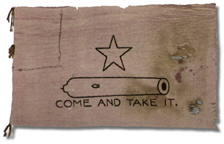
San Antonio Express newspaper, November 5, 1935, Tuesday.
Initial observance of Texas Centennial begins in Gonzales Tuesday when San Antonians will figure in a parade which will start at the boom of a cannon remindful of the famous Gonzales cannon which figured in the first hostilities in the struggle for independence and gave rise to the first Long Start flag.
Governor James V. Allred and other dignitaries are expected to witness the parade which opens the celebration at 1 p.m. Gonzales' Centennial exposition will continue for five days.
San Antonio will be represented in the parade by a Fiesta de San Jacinto float on which will ride members of the Daughters of Republic dressed in the fashions of '36 to represent a quilting party of that time. Alamo Mission Chapter members who will ride on the float are: Mrs. Gus Jones, Mrs. J. M. Olivarri, Mrs. Herbert Hearndon, Mrs. Lee Miller, Mrs. Joseph M. Carnal, Mrs. Henry Wofford, Mrs. Leita Small, Mrs. J. E. King, Mrs. Ethel Tom, Mrs. J. L. Browne and Mrs. Eugene Holmgreen. Mrs. R. F. Martin, president of the Presidio Chapter of Crystal City, also will ride on the float.
Jack Raybould, manager of the Fiesta Association, will be a judge of floats.
San Jacinto Fiesta association will be represented by P. G. Lucas, president, P. E., Gragg, H. G. Wharton, D. A. Powell, Ed Brenstel and Fred Felty. Felty will also represent the Junior Chamber of Commerce, whose delegation will be headed by Thurman Guess, chairman of the state affairs committee. Others will be Albert Russ, Walter Walker and George H. Tucker, secretary.
Gonzales, the "Lexington of Texas," marked the beginning of hostilities with Mexico on Oct. 2, 1835. A celebration was held last Oct. 2 in observance of the 100th anniversary of the battle but the formal exposition was withheld until the period from Nov. 5 to 10.
The Battle of Gonzales, resulted from a demand of the commander of Bexar for the return of a small cannon left in Gonzales some years previous with members of the DeWitt colony for their protection against Indians. There were 13 men in the settlement able to bear arms and these decided to resist the demand. The cannon was buried. All boats were removed to the Gonzales side of the Guadalupe River and breastworks were thrown up. The Gonzales men obtained aid from colonists along the Colorado River, and on Oct. 2, 1835, when the Mexican forces demanded surrender of the cannon, John H. Moore, who had been elected colonel and leader of the Texans, brought the cannon from its hiding place.
Attached to the cannon was the Gonzales flag. It is described by historians as about six feet in length. On it was painted the cannon barrel. Above the cannon was the Lone Star while underneath the cannon was painted the words, "Come and Take it."The cannon was hauled across the river and the Texans began to fire on the
Mexicans who proposed a parly which was rejected. The Mexicans withdrew toward San Antonio. Thus was the first battle for Independence fought in the struggle that was to continue until the next year when the Texans finally routed the Mexicans at San Jacinto.
The Gonzales celebration will feature an exhibition of historical relics, heirlooms and articles dating back before the days of independence. A county agricultural fair will feature the celebration also. A sports program, visitation to points of historic interest near Gonzales and many other features are to be held.